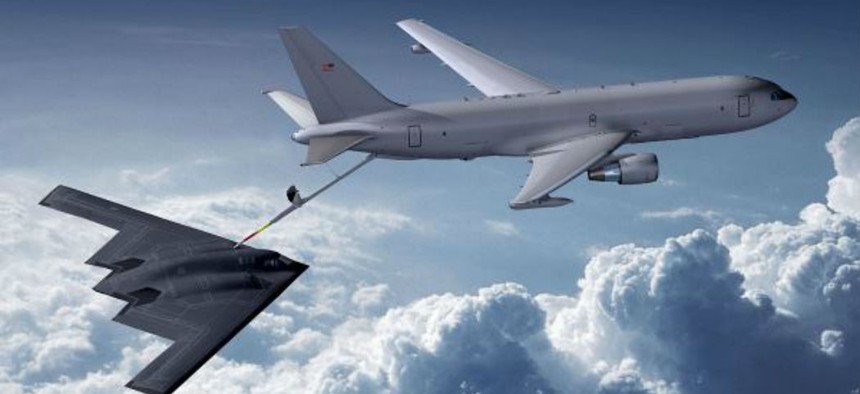Recent tests show new Air Force tanker can withstand electronic attack
The new KC-46A refueling aircraft successfully withstood both stationary and inflight electromagnetic warfare testing.
In a threat environment that is rapidly expanding into the electromagnetic spectrum, the KC-46A Pegasus has just successfully proved its immunity to electromagnetic pulse weapons. Eliminating a major operational risk and an obstacle on the way to product delivery, according to Boeing executives.
“The KC-46A tanker is protected by various hardening and shielding technologies designed into the aircraft to negate any effects on the aircraft. This successful effort retires one of the key risks on the program,” said Mike Gibbons, Vice President and Manager of the Boeing KC-46A program.
Positioned on top of a special landing pad, the KC-46A was hit with electromagnetic pulses, which are induced by sending an electrical current through a large coil to create a momentary magnetic field. Boeing reports that the KC-46A was also tested using electromagnetic pulses directed at the aircraft while it was airborne.
The KC-46A successfully completed the tests. Both the aircraft itself and the wing air-refueling pods withstood the electromagnetic pulse tests, according to Charles Ramey, a spokesperson for Boeing.
The specific details on the technology behind the KC-46 aircraft’s immunity to electromagnetic attack are not available. However, according to industry reports, most electromagnetic-hardened technology uses chips that are built on insulating substrates, such as silicon or sapphire, rather than the typical semiconductor chip wafers. The computational systems also often use magneto-resistive random access memory (MRAM). Besides electromagnetic-resistant technology, redundancy within the systems’ hardware and software adds another key to hardening against electronic attack.
The KC-46A is a next generation refueling tanker able to provide inflight refueling service to any fixed-wing aircraft on any mission, according to Air Force statements. The aircraft is equipped with an improved KC-10 boom, center-mounted drogue and wing aerial refueling pods in order to refuel multiple aircraft at once.
However, as an aircraft that can weigh up to 415,000 pounds, the KC-46A faces stealth challenges. Gen. Carlton D. Everhart II, Commander of the Air Mobility Command, described the problem in April saying, “I’ve got airplanes with big fat bodies and long wings…the enemy doesn’t have to look for the fighter [jet], he just has to look for [the refueler].”
Thus, the new KC-46A must be able to defend itself; against both electromagnetic attacks and hostile missiles.
For this reason, the aircraft is also equipped with an ALR-69A radar warning system that notifies the pilot when an enemy radar system has detected the aircraft. It also carries AAQ-24 Large Aircraft Infrared Countermeasure (LAIR-CM) technology. LAIR-CM is a combined missile warning and countermeasure system that uses two different infrared wavelengths to calculate the location of an approaching enemy missile and then electronically attack the missile guidance system of the enemy missile to prevent it from reaching its target.
With electromagnetic tests accomplished, the KC-46A must still undergo more flight testing and receive certification from the Federal Aviation Administration. A spokesperson for the Air Force stated that, “once Boeing receive the remaining design approvals from the FAA, [we] expect testing to proceed on a faster pace.”
Delivery of the first fully operational KC-46A aircraft is still scheduled for this year, with 18 more arriving by October 2018.




